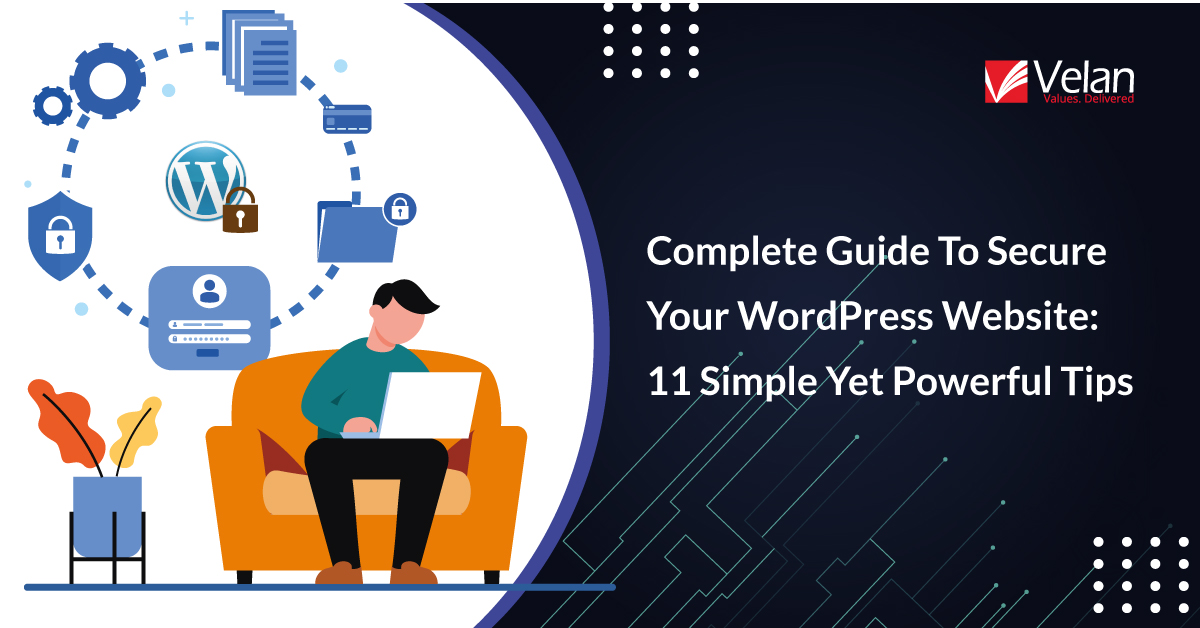[2021 Updated] Complete Guide To Secure Your WordPress Website: 11 Simple Yet Powerful Tips 22 Jun 2021

Regardless of which year you are in, 2015, 2016, or fast forward to 2021, keeping your secure your WordPress website is paramount. WordPress website is, by far, the most preferred option to build a website. It is simple to build as compared to its counterparts, easy to use, and straightforward to comprehend. And these pointers have made it a compelling reason for the hackers to prey on.
No matter how much hard work you have put into launching your WordPress website, it can always find itself in the attacker’s arms. It is not because you didn’t build it securely, but it is because you neglected to keep your WordPress updated, or maybe, you took the updates lightly.
We have quashed some real threats and will give you 100% proven tips to secure your WordPress website. And the tips are updated for 2021.
Before we understand how to secure the WordPress Website, let us look into the WordPress vulnerabilities.
According to the content management system usage investigation report from W3Techs, WordPress is used by 41.5% of all the websites, which is a content management system market share of 64.9%.
It is an open-source management system. WordPress has a specific team that detects and fixes any WordPress security problems that sprout in the main code. The security threats are concealed. It is inevitable that the hackers find some way or the other to prey on WordPress websites. However, updating the websites as soon as the security patches are released into the market will earn you security and hack-proof systems.
What are the top threats to Secure Your WordPress Website?
1. Malicious login attempts
It is similar to the brute force attack method. The brute force attack method in WordPress refers to keying in the different username and password combinations until it is successful. It is one of the simplest ways for hackers to enter into your website and get control of your data.
It is because WordPress does not have any limit to login attempts. It makes it easier for the bots to enter multiple combinations until the successful combination is found. Even otherwise, the multiple attacks on your website can slow your page enabling your host to suspend your account.
2. Malware from pirated themes and plugins
Malicious software, abbreviated as malware, is the most common threat to the website. If you suspect your WordPress website is hacked, it means malware has been injected into your website’s files. You must immediately look into the recently changed files.
WordPress is vulnerable to the four most common malware infections. They are:
- Backdoors
- Pharma hacks
- Malicious redirects
- Drive-by downloads
When a plugin or a theme is pirated, the license checking features are automatically disabled. It makes the backdoor entry for malware easier. The malware can be detected and must be cleaned by getting rid of malicious files or by restoring the non-infection version.
3. SQL Injections
Your WordPress website runs on a MySQL database. With an SQL injection, your attacker will be able to create an admin account and gain complete access to your WordPress website. It can be used to create new data into your database, including links to spam websites.
4. File Inclusion Exploits
After the innumerable login attempts, your WordPress website’s PHP code is the next security threat that the attacker can benefit from. Your website’s code, plugins, and themes run on PHP code.
When vulnerable code is leveraged to load remote files, file inclusion exploits occur making it easy for the intruders to gain access to your website. They will target the wp-config.php file, one of the crucial files in your WordPress installation.
5. Cross-Site Scripting (XSS)
It is another most common vulnerability found in WordPress plugins.
The mechanism of Cross-Site Scripting is: an intruder will get the victim to load web pages with malicious javascript scripts. These scripts load without the knowledge of the visitor and steal data from the victim’s browser.
How do attackers hack? Secure Your WordPress Website
All the websites on the internet are constantly monitored for attacks. The hacker will easily scan thousands of pages and try to attempt logins.
And that is only one hacker. There are thousands of such hackers constantly monitoring the website for an attack.
We are not referring to a hacker as a human being but an automatic ‘hacker’ bot. The hacker bots are automated software that will crawl the web to detect a weakness in the websites.
11 Secure Your WordPress Website security tips
Ringing a bell: Following these 11 simple, yet powerful WordPress security tips will safeguard your website from attackers.
1. Update your WordPress regularly
Every time you see a notification that says “You have an update for your WordPress”, ruthlessly press the update button. It is one of the safest ways to avoid potential threats and WordPress security problems. Login to your admin account and update your WordPress core, themes, plugins, and passwords. If you are using a premium account, ensure your updates are automatic and happen immediately when an update is released. Anything inside and dependant on your WordPress website needs to be updated regularly.
2. Use a powerful and complex password
Ensure your login password is strong, complex, and greater than at least 8 characters. And your passwords must be different for all the accounts. Never use a single password for all the online accounts. Regularly change your passwords and ensure to keep the combination different every time.
3. Enable WordPress two-factor authentication
Two-factor authentication is an additional protection layer to your WordPress login. It is similar to receiving a time-sensitive OTP besides entering the password for login. It is one of the most secure ways to protect your login and completely shun entry for malicious login attempts, i.e. the brute force attack method.
4. Install a WordPress security plugin
We cannot stress enough different ways to secure your WordPress website. And one such method is to install a WordPress security plugin. It is auxiliary protection to secure your website. Check for the trusted and reliable plugins and activate them. A reliable and secure plugin will manage most of the technical aspects of your WordPress’s security, so you don’t need to continuously monitor.
5. Back up your site frequently
Backing up your WordPress refers to creating multiple copies of your site’s data and storing it in multiple places, securely. In case of any threats, you can restore the site from the backup copy easily.
6. Limit access to your server
If you have multiple users that need access to the site, be judicious about who really needs access to your site and server. You must be careful and dictate permissions to the appropriate people.
If you really require many users, then limit their accessing functionalities by giving them access to the essential files required for completing their job. Ideal permissions dictate who has permission to create, modify, update, and read files.
7. Run malware scans timely
Religiously surveil potential malware threats by running timely malware scans. Specialized plugins or software are available to run security scans extensively throughout your website. If something malicious is found, it will be removed immediately. They work as an anti-virus.
8. Install firewalls
Firewalls protect your computer from multiple online threats. Any strange occurrence trying to establish a connection with your website will be detected, stopped, and enquired.
A bonus tip: Install a firewall on your computer. Although it does not have a connection with your WordPress website, it is still worth an effort. You use your computer to connect with the admin account. And if the connection with your computer is compromised, your data will also be compromised. And the attacker can still steal your data through your computer.
Needless to say, install a firewall, a.k.a security tools for your WordPress website. The firewall will detect, scan, and prevent the entry of viruses, hacker attacks, malicious SQL injections, malware, or any kind of security compromising threats.
9. Use SSL
SSL is the Secure Socket Layer. It is a great protection agent for your admin data. It secures the data transfer between your browser and the server.
You can get an SSL certificate for your website by buying one from a third-party agent, or you could ask your hosting provider to provide one. Most of the hosting providers feature SSL in their plans.
10. Rename your login URL
By default, your website login URL will be YOUR_WEBSITE.com/wp-login.php, and the admin account login will be YOUR_WEBSITE.com/wp-admin.
These two URLs are the hacker’s favorite to attack to prey on the wp-config.php files. Changing the 2 URLs will reduce the chances of intrusion. We recommend paying for a custom URL to make guessing harder for the intruders. After all, your website’s security is more worthy.
For example, the iThemes security plugin has an option for this. Your login URL will change into YOUR_WEBSITE.com/Welcome_to_my_site. Another simple, yet powerful security to protect your WordPress.
11. Protect your wp-config.php
The wp-config.php file is one of the most crucial and most vulnerable files on your WordPress. It stores complete and critical data about your WordPress installation. It is inherently the anchor of your WordPress website. If it gets infected, then your reputation is at stake.
You can move the wp-config.php one step above your WordPress root directory. Doing this will not bemuse your site and also prevent the hackers from finding the file.
Bonus Tip: Outsource to a WordPress expert
This option especially applies to small and medium business owners, and even for large organizations.
The best way to secure your WordPress website is by outsourcing it to a WordPress security expert, or you can hire a professional to maintain your WordPress security. Your experts will handle it all, from developing the site and installation to taking care of the technical aspects and updating regularly.
Precisely, this is what we do at Velan. Our WordPress security experts will manage it all, from setting up your basic security features to handling the updates in a timely manner. We provide regular backups and have the latest versions available anytime you need. We have a lot of maintenance plans, and you can sign up for customized security packages. Choose your package, and we will look after your WordPress security.
Key Takeaways
So, the big question? – Is your WordPress secure if you follow all the best practices above?
Yes. Your WordPress will be secure. While no content management system is 100% secure, following the simple tips will prevent direct hacks resulting from above. Most of the attacks happened in the past because either of the above tips was overlooked.
- Update your WordPress regularly – security patches, themes, plugins, passwords.
- Use a powerful and complex password. Ensure to change your password once in 6 months at least. Keep distinct passwords for all online accounts.
- Enable WordPress two-factor authentication.
- Install a trusted WordPress security plugin.
- Back up your site frequently and store the backed-up copies in secure places.
- Limit access to your site and server. Dictate permissions for enhanced security.
- Run malware scans timely.
- Install firewalls on your computer and your WordPress site.
- Use SSL.
- Rename your login URL.
- Protect your wp-config.php file.
- Consider outsourcing your WordPress security to a WordPress security expert like Velan.





